Written by Steve Patterson. In this Photoshop effects tutorial, well learn how to easily create and add lightning to an image with Photoshop! Theres a few different ways to create lightning using Photoshop. The way well learn here is my favorite because, unlike real lightning in nature, this technique gives us lots of control over where the lightning appears and what it looks like in our image. After weve created the initial lightning bolt, well learn how to colorize it and how to brighten things up with some highlights to complete the effect!
Ill be using Photoshop CS5 throughout this tutorial but theres nothing well be doing thats specific to CS5 so any recent version of Photoshop will work.
Heres what the final lightning effect will look like (the original image without the lightning is available from the Fotolia image library):
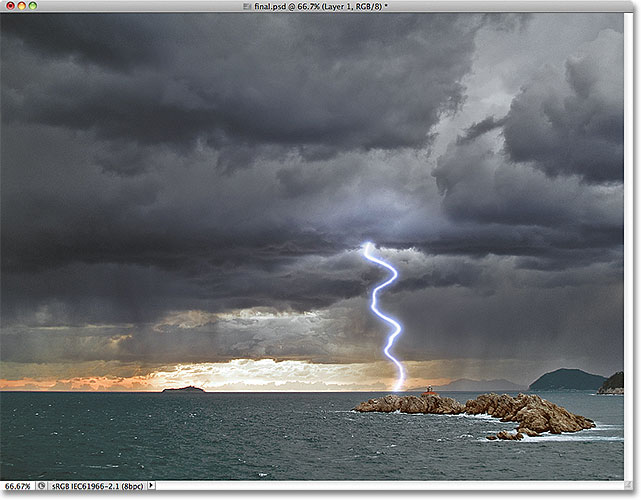
The final lightning effect.
Lets get started!
Step 1: Add A New Blank Layer
With the photo newly opened in Photoshop, if we look in the Layers panel, we see that we currently have one layer the Background layer which is the layer the photo is sitting on. Were going to add our lightning above this layer so we dont damage the original image. Click on the New Layer icon at the bottom of the Layers panel:
Click on the New Layer icon.
This adds a new blank layer named Layer 1 above the Background layer:
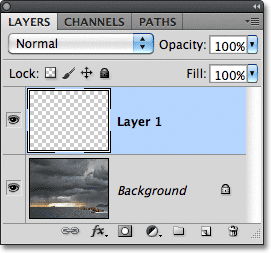
Photoshop automatically names the new layer Layer 1.
Step 2: Select The Lasso Tool
Select the Lasso Tool from the Tools panel:

Select the Lasso Tool.
Step 3: Draw A Selection Around The Area Where The Lightning Will Appear
With the Lasso Tool selected, decide where you want the lightning bolt to appear in the image and draw a selection outline around that general area. Here, Ive drawn my selection outline in the lower right of the photo:
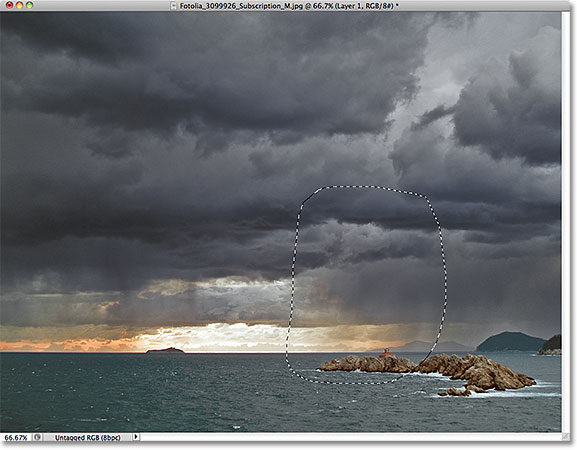
Draw a selection around the general area where the lightning bolt will appear.
Step 4: Fill The Selection With White
Go up to the Edit menu in the Menu Bar along the top of the screen and choose Fill:
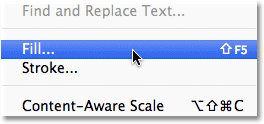
Go to Edit > Fill.
This opens the Fill dialog box. Set the Use option at the top of the dialog box to White:
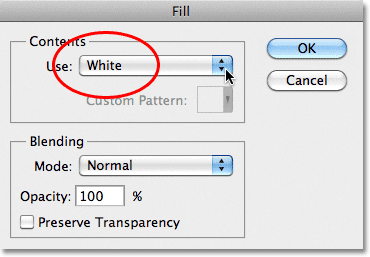
Set the Use option to White.
Click OK to close out of the Fill dialog box. Photoshop fills the selected area with white in the document:
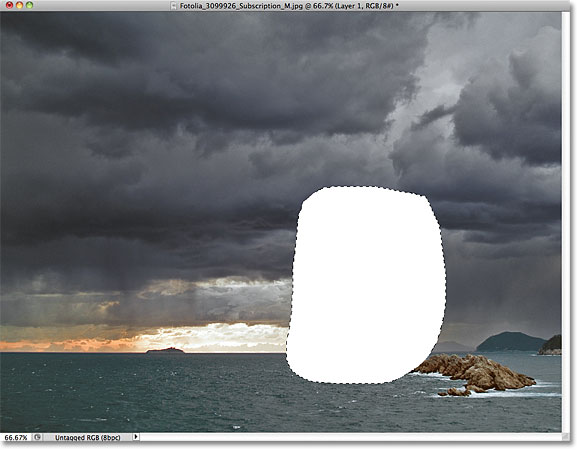
The selected area is now filled with solid white.
Step 5: Select The Brush Tool
Select the Brush Tool from the Tools panel:

Select the Brush Tool.
Step 6: Set The Foreground Color To Black
We need to paint with black, and Photoshop uses the current Foreground color as the paint color, which means we need to make sure our Foreground color is set to black before we start painting. Press the letter D on your keyboard, which resets the Foreground and Background colors to their defaults, making black the Foreground color (white becomes the Background color). You can see what the colors are set to by looking at the Foreground and Background color swatches near the bottom of the Tools panel:

Make sure the Foreground color (top left swatch) is set to black.
Step 7: Choose A Round, Hard Edge Brush
With the Brush Tool selected, right-click (Win) / Control-click (Mac) anywhere inside the document, which opens the Brush Picker, and choose a round, hard edge brush by clicking on its thumbnail. Im using Photoshop CS5 here, but dont worry if youre using CS4 or earlier and your selection of brushes looks different from mine. Any round, hard edge brush will do. Once youve selected a brush, press Enter (Win) / Return (Mac) to close out of the Brush Picker:
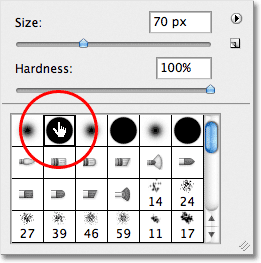
Click on any round, hard edge brush to select it.
Step 8: Paint A Jagged Black Stroke Through The White-Filled Selection
Paint a jagged black stroke through the white-filled selection where you want the lightning bolt to appear. The lightning will eventually appear along the right edge of the paint stroke, where the black and white meet. For best results, use a fairly small brush. You can change the size of the brush from the keyboard. Press the left bracket key ( [ ) to make the brush smaller. Pressing the right bracket key ( ] ) makes the brush larger. When youre done, your black stroke should look something like this:
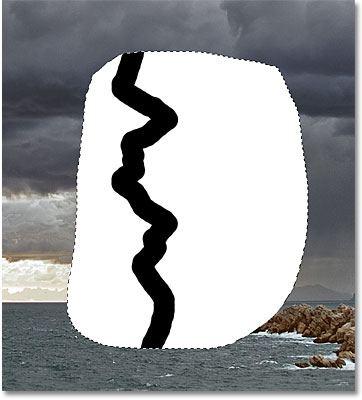
Use a small brush to paint a jagged stroke through the selection.
Step 9: Paint The Area To The Left Of The Stroke Black
Once you have your initial black stroke, continue painting over the area to the left of the stroke until its completely covered in black as well. Only the area to the right of the stroke should remain white. You may want to increase the size of your brush so you can paint over this area more quickly by pressing the right bracket key ( ] ) a few times:
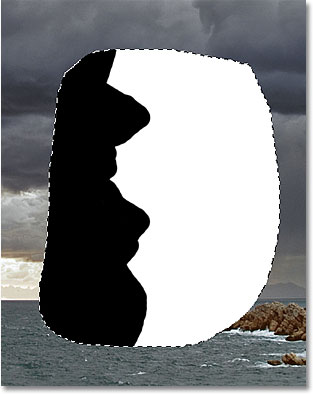
Paint over the area to the left of the stroke to fill it with black.
Step 10: Apply The Gaussian Blur Filter
Next, we need to soften the edge where the black and white areas meet, and we can do that by blurring it. Go up to the Filter menu at the top of the screen, choose Blur, then choose Gaussian Blur:
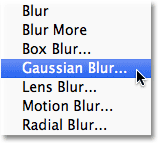
Go to Filter > Blur > Gaussian Blur.
This opens the Gaussian Blur filters dialog box. Keep an eye on the document as you drag the Radius slider at the bottom of the dialog box towards the right. The further you drag the slider, the more blurring youll apply and the softer the edge will become. The transition area between black and white created by the soft edge is what will eventually become the lightning bolt, so the softer the edge, the wider the lightning bolt will be. For my image, Im going to set my Radius value to around 9 pixels. The Radius value you end up using may be different depending on the size of the image youre working with:
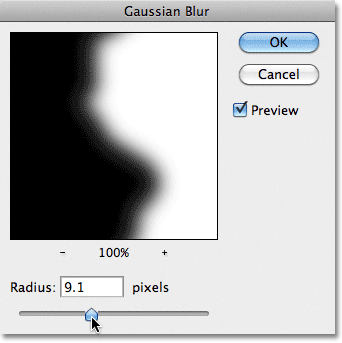
Increase the Radius value to soften the edges of the black stroke.
Click OK to close out of the dialog box. The edge should now look similar to this:
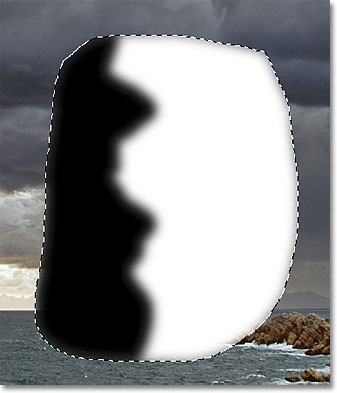
The soft edge of the stroke will soon become the lightning bolt.
Step 11: Apply The Difference Clouds Filter
Go up to the Filter menu, choose Render, then choose Difference Clouds:

Go to Filter > Render > Difference Clouds.
Theres no dialog box for the Difference Clouds filter, so Photoshop simply goes ahead and runs it. We can see in the document that the soft edge we created a moment ago now begins to look like a lightning bolt, although its the wrong color at the moment:
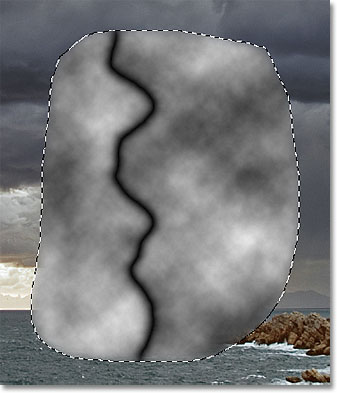
The lightning bolt begins to appear.
Step 12: Invert The Image
Go up to the Image menu, choose Adjustments, then choose Invert:
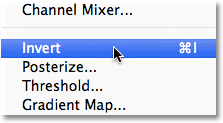
Go to Image > Adjustments > Invert.
This inverts the brightness values in the selected area, making light areas dark and dark areas light, which turns our lightning bolt from black to white:
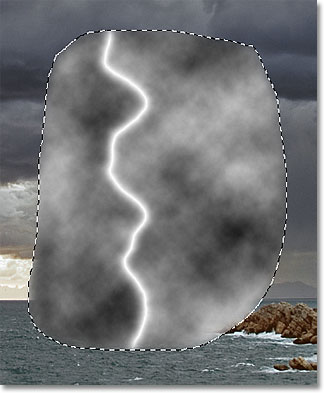
Inverting the image changes the lightning bolt from black to white.
Step 13: Apply The Levels Command
Go back up to the Image menu, choose Adjustments once again, and this time, choose Levels:

Go to Image > Adjustments > Levels.
This opens the Levels dialog box. Were going to use Levels to darken the clouds around the lightning bolt so the area surrounding it is black. First, click on the black slider below the bottom left side of the histogram in the center of the dialog box and begin dragging it towards the right. As you drag, youll see the areas around the lightning bolt begin to fade into black. Continue dragging the black slider towards the right until most of the clouds have disappeared:
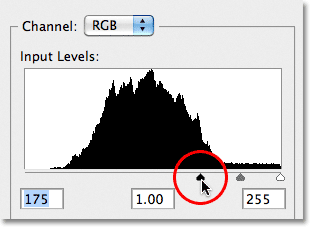
Drag the black slider towards the right to darken most of the area around the lightning bolt.
Most of the area should now be darkened to black. A few gray areas will remain:
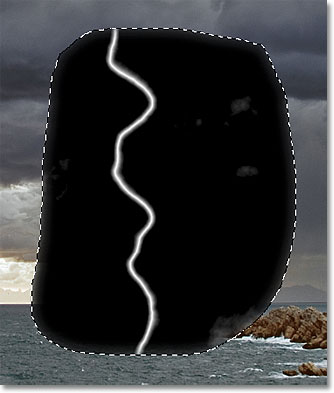
Only a few gray areas remain around the lightning bolt.
Click on the gray slider in between the black and white sliders and begin dragging it towards the right as well, which will fade the remaining gray areas to black. Its important, though, that you dont darken things so much that the lightning bolt becomes harsh looking with hard, jagged edges. You want to keep a soft, subtle fuzziness to the lightning, so darken things as much as you can with the black and gray sliders, but dont worry if theres still a few remaining areas of gray. Well clean things up next:
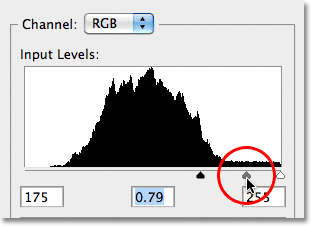
Drag the middle gray slider towards the right to darken the remaining gray areas.
Click OK when youre done to close out of the Levels dialog box. The image should now look similar to this:
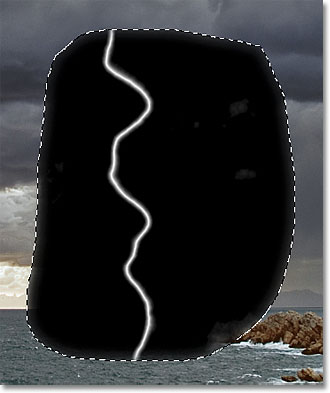
Most of the gray areas around the lightning bolt have now been darkened to black.
Step 14: Deselect The Area
Go up to the Select menu at the top of the screen and choose Deselect to remove the selection outline from around the area. Or, for a faster way to deselect a selection, press Ctrl+D (Win) / Command+D (Mac) on your keyboard. Either way will do:
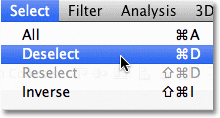
Go to Select > Deselect to deselect the area.
Step 15: Paint With Black To Clean Up Any Remaining Gray Areas
With your Brush Tool still selected, right-click (Win) / Control-click (Mac) anywhere inside the document to once again open the Brush Picker. Keep the same round brush selected, but lower the Hardness of the brush to 50%. This will soften the brush edge. Press Enter (Win) / Return (Mac) when youre done to close out of the Brush Picker:
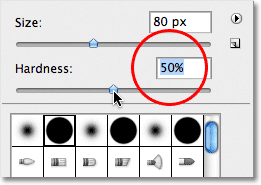
Lower the brush hardness to 50% to soften the edge.
Then, with black still as your Foreground color, paint over any remaining gray areas around the lightning bolt to clean them up. The reason we softened the brush edge is in case there are any remaining gray areas close to the lightning bolt itself. This way, we can paint close to the lightning without flatting its soft edge:
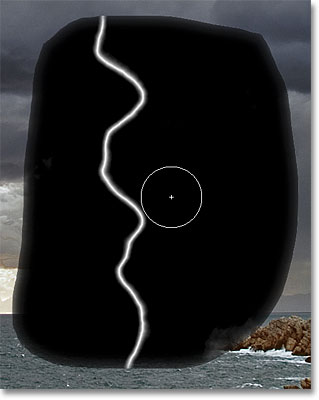
Clean up any remaining gray areas by painting over them with black.
Also, if you look around the outer edges of the black area, youll see that they appear somewhat transparent, which is a result of us running the Gaussian Blur filter earlier. These transparent edges will cause problems, so paint around the outer edges with your brush to cover them with solid black. When youre done, everything other than the lightning bolt should be black. Dont worry that the whole thing looks like an ugly mess for now. It will look much better in a moment:
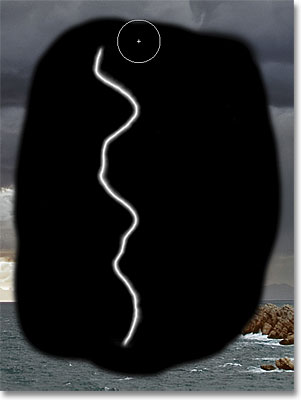
Paint over the transparent outer edges.
Step 16: Change The Blend Mode To Screen
With everything now black except the lightning bolt itself, go up to the Blend Mode option at the top of the Layers panel and change the blend mode from Normal to Screen:
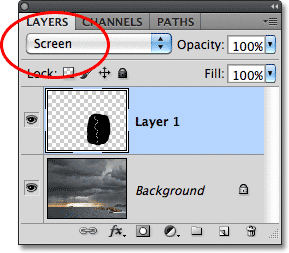
Change the layers blend mode from Normal to Screen.
The Screen blend mode hides all the black areas on the layer, keeping only the lightning bolt itself visible:
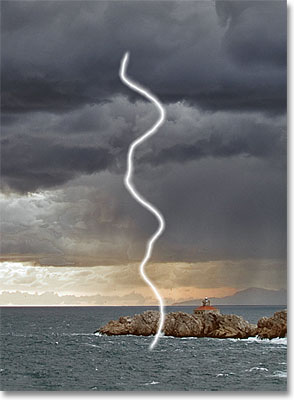
Only the lightning bolt remains visible on the layer.
Step 17: Move And Resize The Lightning With Free Transform
Go up to the Edit menu at the top of the screen and choose Free Transform, or press Ctrl+T (Win) / Command+T (Mac) to access the Free Transform command with the keyboard shortcut:
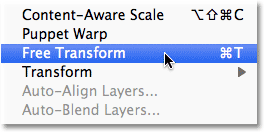
Go to Edit > Free Transform.
This places Photoshops Free Transform box and handles around the lightning bolt. Move the lightning into position by clicking anywhere inside the bounding box and dragging it with your mouse. To resize the lightning, simply drag any of the handles. If you hold down your Ctrl (Win) / Command (Mac) key, this will temporarily switch you to Distort mode which will give you more freedom when dragging the handles. Release the key to switch back to standard Free Transform mode. Once youve moved and resized the lightning, press Enter (Win) / Return (Mac) to accept the change and exit out of Free Transform:
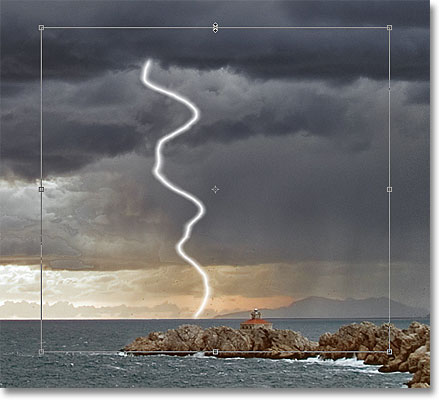
Use Free Transform to resize the lightning and move it into place.
Step 18: Duplicate The Layer
Lets add a glow to the lightning. Go up to the Layer menu, choose New, then choose Layer via Copy, or press Ctrl+J (Win) / Command+J (Mac) to access the same command with the keyboard shortcut:
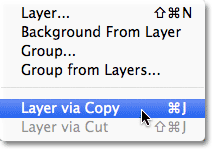
Go to Layer > New > Layer via Copy, or press Ctrl+J (Win) / Command+J (Mac).
Either way tells Photoshop to make a copy of Layer 1 and place it above the original in the Layers panel. Notice that the copy is automatically set to the Screen blend mode for us:
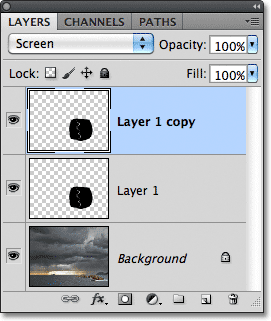
Photoshop names the new layer Layer 1 copy.
Step 19: Apply The Gaussian Blur Filter
To create a glow around the lightning, we just need to blur the copy we created. Go up to the Filter menu, choose Blur, then choose Gaussian Blur as we did before. Im going to again set my Radius value to around 9 pixels, which adds a nice glow effect. The value you use may be different depending on the size of your image:
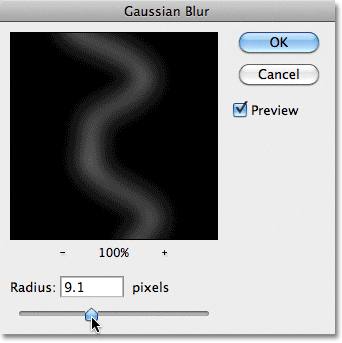
Drag the Radius slider to blur the copy of the lightning and create a blur effect.
Click OK when youre done to close out of the Gaussian Blur dialog box. You should now see a subtle glow around the lightning:
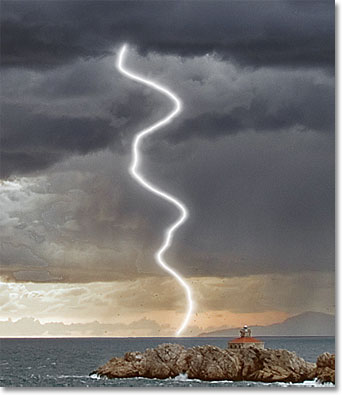
The lightning after adding a soft glow.
Step 20: Duplicate The Layer
The initial glow effect is a bit too subtle so lets increase its intensity. Press Ctrl+J (Win) / Command+J (Mac) to quickly duplicate the blurred layer. The glow will appear stronger. If you find that its now too strong, lower the layers opacity to fine-tune the results. Youll find the Opacity option at the top of the Layers panel directly across from the Blend Mode option. Im going to leave my opacity set to 100%:
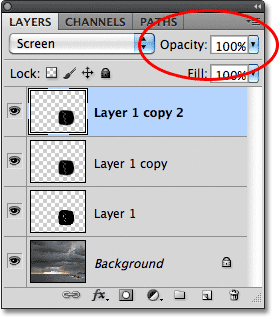
Duplicate the blurred layer to strengthen the glow effect, then lower the Opacity if needed to fine-tune the results.
Heres my result with the glow now more intense:
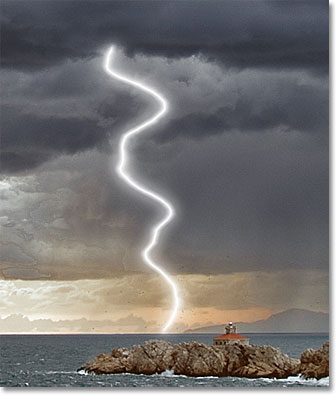
The effect after duplicating the blurred layer.
Step 21: Merge The Lightning Layers
Go up to the Layer menu and choose Merge Down, or press Ctrl+E (Win) / Command+E (Mac) to access the Merge Down command with the keyboard shortcut. Then do the same thing a second time. This will merge the two glow effect layers down onto Layer 1 with the initial lightning bolt:
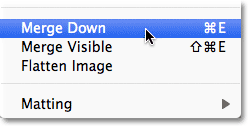
Go to Layer > Merge Down, or press Ctrl+E (Win) / Command+E (Mac), then do the same thing again.
You should now be back to a single layer, Layer 1, above the Background layer in the Layers panel:
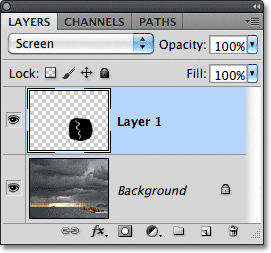
The glow effect layers have been merged down with the lightning onto Layer 1.
Step 22: Colorize The Lightning With Hue/Saturation
If you want to colorize the lightning, go up to the Image menu, choose Adjustments, then choose Hue/Saturation:
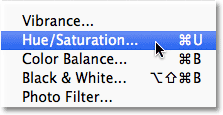
Go to Image > Adjustments > Hue/Saturation.
This opens the Hue/Saturation dialog box. Select the Colorize option, then drag the Hue slider to select a color for the lightning. Im going to select a blue/purple color by setting my Hue value to 232. Of course, you can choose any color you like. To make the color appear more intense, increase the Saturation value. Ill set mine to 50%. Click OK when youre done to close out of the dialog box:
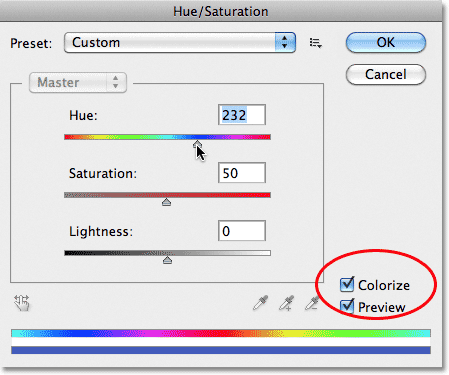
Select the Colorize option, then choose a Hue and Saturation level.
Heres what my lightning looks like after colorizing it:
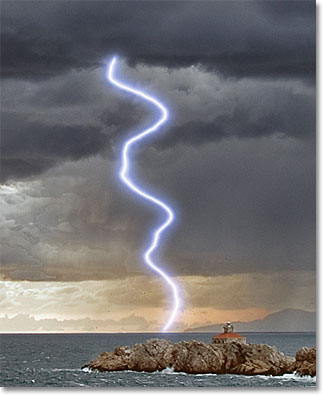
The lightning after giving it a bluish purple color.
Step 23: Merge The Layers Onto A New Layer
Hold down your Alt (Win) / Option (Mac) key and with the key held down, go up to the Layer menu and choose Merge Visible:
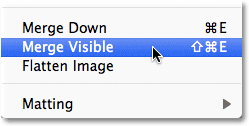
Hold down Alt (Win) / Option (Mac) and go to Layer > Merge Visible.
This merges the existing layers onto a new layer above them in the Layers panel:
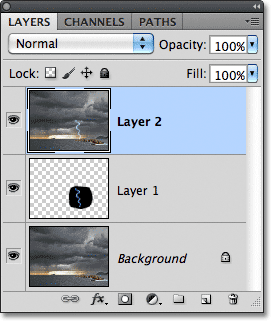
The two existing layers are merged onto a third layer.
Step 24: Select The Dodge Tool
Select the Dodge Tool from the Tools panel:

Select the Dodge Tool.
Step 25: Set The Range Option To Highlights And Deselect Protect Tones
With the Dodge Tool selected, set the Range option in the Options Bar along the top of the screen to Highlights. Leave Exposure set to 50%, and uncheck the Protect Tones option:

Set the options for the Dodge Tool in the Options Bar.
Step 26: Lower The Brush Hardness To 0%
The Dodge Tool is considered a brush in Photoshop and we can adjust the softness of its edges the same way we can with the standard Brush Tool. Right-click (Win) / Control-click (Mac) anywhere inside the document to bring up the Brush Picker, then lower the Hardness for the Dodge Tool all the way down to 0% to give us the softest edges possible. Press Enter (Win) / Return (Mac) when youre done to close out of the Brush Picker:
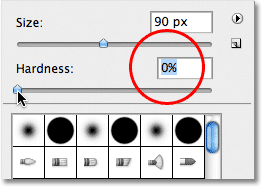
Lower the edge hardness of the Dodge Tool to 0%.
Step 27: Paint With The Dodge Tool To Brighten Areas
Finally, paint over certain areas with the Dodge Tool to brighten them and add some lighting highlights. Each time you paint over the same spot with the Dodge Tool, youll brighten that area a little more. The clouds around where the lightning bolt is shooting out from would be brightened by the lightning, so Ill use a medium size brush to paint over that area a few times:
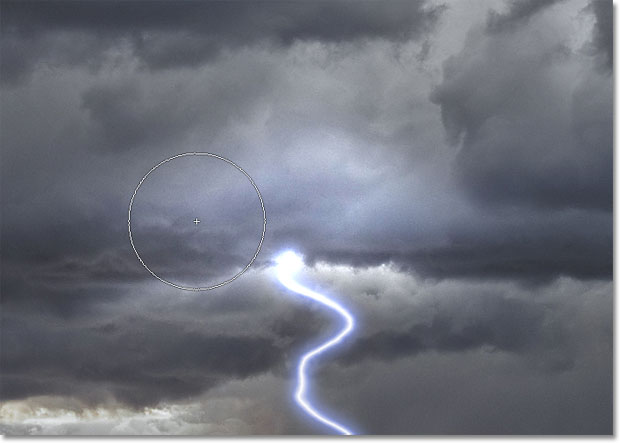
Painting with the Dodge Tool to brighten the clouds where the lightning begins.
Ill use a smaller brush and simply click a couple of times on the spot where the lightning strikes the ground (or in this case water) to add a highlight there as well:
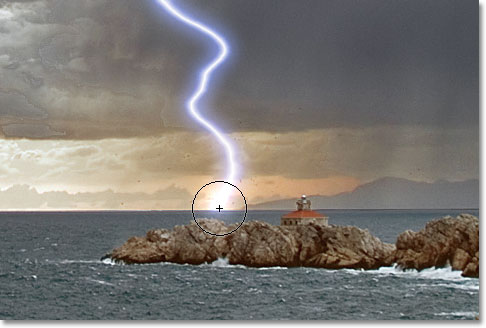
Clicking on a spot with the Dodge Tool sometimes works better than painting over it.
And finally, Ill paint over a couple of spots along the lightning bolt itself to add some highlights to it:
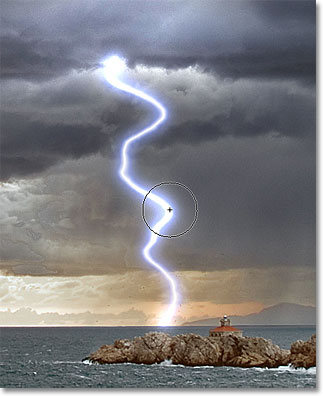
Adding a couple of highlights along the lightning bolt itself.
Step 28: Lower The Opacity Of The Top Layer If Needed
If, after adding your highlights with the Dodge Tool, you find they look a bit too intense, simply lower the opacity of the top layer. Im going to lower mine down to 70%:
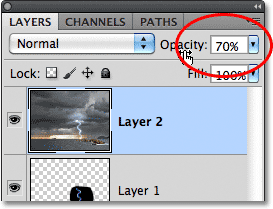
Lower the top layers opacity if needed to reduce the highlights.
Here, after lowering the opacity, is my final lightning effect:

The final Photoshop lightning effect.
And there we have it! Thats how to easily add lightning to an image with Photoshop!
Download our tutorials as print-ready PDFs! Learning Photoshop has never been easier!
You May Also Like...
Lightning Effect With Photoshop
In this photo effects tutorial, learn how to easily create and add lightning to an image with Photoshop!
How to Create a Lightning Effect With Photoshop: 8 Steps
How to Create a Lightning Effect With Photoshop. It's relatively easy to create lightning using Adobe Photoshop. In the example, we use a less realistic more
Spooky Lightning in Photoshop Tutorial - PhotoshopCAFE
Photoshop tutorial, how to electrify your images with lightning in Photoshop. This spooky graveyard will have lightning created and added in Photoshop
How to Use the Lightning Effect in Photoshop | eHow
Adobe Photoshop can create lightning effects that you can add to pictures or use as a picture. You can make several different kinds of lightning using many different
10 Very Useful Lightning Brushes for Photoshop
10 Very Useful Lightning Brushes for Photoshop. 20 really amazing , handy and useful photoshop lightning effect brush packs
Photoshop Help | Add Lighting Effects (CS5)
In 64-bit versions of Mac OS, Lighting Effects is available only if Photoshop is running in 32-bit mode.
Photoshop Tutorial How to Create a Lightning
This Photoshop tutorial go through some really basic and important Photoshop techniques while showing you how to create a fearsome lightning bolt from scratch
Lightning Effect With Photoshop | 101 Photoshop Tutorials
Written by Steve Patterson. In this Photoshop effects tutorial, well learn how to easily create and add lightning to an image with Photoshop! Theres a few different
Learning | Lightning Effects | Photoshop.com
Remove the background behind lightning and flame images in Photoshop CS3 so you can add special Layer Effects, and avoid Blending Modes when necessary.
Photoshop Tutorial: How to Make Lightning! -HD-
In this tutorial, you will learn how to make a lightning effect in Photoshop CS3. Be sure to SUBSCRIBE because there will be a new tutorial every week.
ConversionConversion EmoticonEmoticon